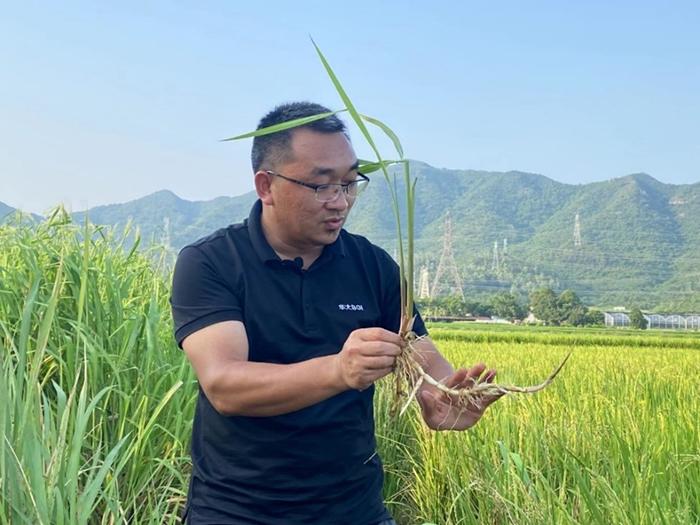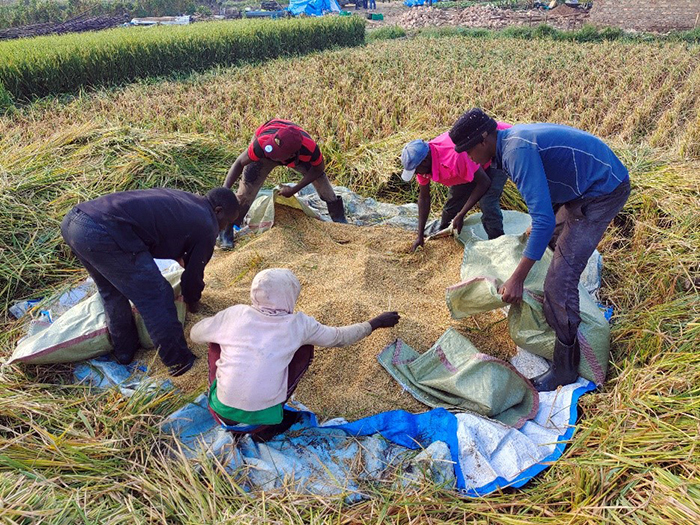Perennial rice incorporates African wild rice genes and halves production cost l BGI Perspectives
2022-10-16
An estimated 670 million people are
projected to be undernourished in 2030, as noted in FAO’s The State of Food Security and
Nutrition in the World 2022
report. Conflict, COVID-19, climate extremes and economic shocks are listed as the
key factors contributing to food insecurity and malnutrition.
Against this backdrop, what are international scientists doing? On the occasion of World Food Day, Dr. Liu Huan, Head of BGI Bioverse, notes it is crucial to enhance yields of key crops such as rice. Dr. Liu makes three key points:
- Compared to cultivated rice, perennial rice can reduce production costs by over 50%
- Perennial rice incorporates African wild rice genes, which enhances its stress tolerance
- The reach for perennial rice planting includes 18 countries such as Uganda and Ethiopia.
Perennial rice’s hidden secrets

Perennial rice in the field – note that the crop base shows signs of previous harvests
Do you know that wild rice species – similar to ginger – develop rhizomes, modified stems that grow underground horizontally, as a means of vegetative reproduction? However, cultivated rice do not possess rhizomes. This means cultivated rice must be planted on a per-season basis. Whereas perennial rice can be harvested over many years since it incorporates wild rice genes and its rhizomes for reproduction.
Perennial rice: In search of a greener and more efficient crop
So what does this mean for farmers? Keep in mind that traditional rice cultivation consists of six processes: buy seeds, raise seedlings, ploughing, transplanting, field management and harvesting. With perennial rice, the farmers skip the first four stages and concentrate their efforts on field management and harvesting.
Compared to cultivated rice, perennial rice can reduce production input costs by more than 50%. Farmers are potentially looking at US$11.40 - 13.70 savings per acre based on labor costs in Yunnan, China. If farmers plant two crops in one year, the estimated cost savings is US$22.80 - 27.30 per acre. China has 65.9 million acres of land dedicated to rice farming. Therefore, the theoretical social and economic value of these savings is estimated at US$1.5 billion.
Growing perennial rice not only greatly reduces production costs, but also eliminates the need to plough the field for many years, reducing labor, fertilizer and pesticide inputs and enhancing the natural properties of the soil. This can greatly alleviate labor shortage faced by farmers, while as well as bringing associated ecological and environmental benefits.
Perennial rice also has the advantage of high yield and quality. In terms of yield, in Yunnan, the yield reaches 164 kilograms, compared to China’s average of 75 kilograms per acre. Dr. Liu believes that more varieties can be cultivated, including more disease-resistant varieties, and developing high-yielding and high-quality varieties that are adapted to different climates. There are all future areas of research for BGI Bioverse team.
Dr. Liu commented, “China produces a quarter of the world's grain with less than 10 percent of its arable land. When we consider the potential savings, enhanced yield as well as environmental benefits, perennial rice can be truly revolutionary for farmers.” Not only has perennial rice been selected as one of the FAO's 2018 International Agricultural Technology Innovations, it is also one of the 29 rice varieties promoted by China’s Ministry of Agriculture and Rural Affairs for 2022.
Perennial rice has relatively wide regional adaptability. Perennial rice has been planted at 117 locations within China, covering 13 major rice-growing provinces while covering 17 countries internationally, including Uganda, Ethiopia, Laos, Myanmar and Bangladesh, showing its potential for development across various climates.
Perennial rice’s African “father” gene

Dr. Liu Huan, Chief Scientist of BGI Bioverse, shows African wild rice’s (Oryza longistaminata) rhizomes
Generally speaking, higher rice yields require intensive cultivation, field management and favorable weather conditions. What if such conditions are not available? BGI Bioverse's perennial rice is well-placed to overcome this challenge as it incorporates Oryza longistaminata wild rice genes from Africa, which enhances stress tolerance.
The Academy of Agricultural Sciences in Uganda
have collaborated with BGI Bioverse to conduct research trials. With less intensive
field management, perennial rice still managed to achieve a single-season yield
of nearly 82 kilograms per acre.

Perennial rice harvest in Uganda near Lake Victoria
Perennial rice can produce high yields with less intensive field management. This indicates perennial rice has the adaptability to be scaled up in Africa. Rice is the second most important source of calories in Africa with demand growing at more than six percent per year. Further adoption of perennial rice is potentially of great importance to the food supply of African countries.
Dr. Liu notes that BGI Bioverse is ready to share technology and to nurture a team of modern technological agricultural talent in Africa. Working with local partners, BGI Bioverse can develop perennial rice varieties that are more suitable for African cultivation, to further raise farmers’ incomes.

The benefits of cultivating perennial rice in the six stages process
How can multi-omics sequencing technologies help meet climatic challengers?
Apart from its work on existing staple food crops, BGI Group is an active member of the African Orphan Crops Consortium (AOCC). These local orphan crops which have been neglected by the global scientific community, have special adaptability to grow in these environments. The robustness of orphan crops also helps farmers to increase their yields and incomes as global temperatures rise.
The AOCC, in partnership with World Agroforestry (CIFOR-ICRAF), targets to open access the genomic data from some of Africa's most important food and tree crops to improve their nutrition, productivity and climatic adaptability.
Dr. Liu shared that, “We work in partnership at the AOCC. For example, UC Davis takes the lead to train Africa's plant breeders, empowering them to apply their knowledge to their traditional crops and communities. We sequence these orphan crops to identify genes that have potential to impart tolerance to high temperatures, drought, and high salinity while providing excellent nutrition. So far, we have sequenced over ten orphan crops, such as African eggplant, breadfruit, jackfruit and the moringa.”
Additional Reading
Why BGI's perennial rice can be a game changer for farmers in China and beyond | SMCP
About BGI Genomics
BGI Genomics, headquartered in Shenzhen, China, is the world's leading integrated solutions provider of precision medicine. In July of 2017, as a subsidiary of BGI Group, BGI Genomics (300676.SZ) was officially listed on the Shenzhen Stock Exchange.